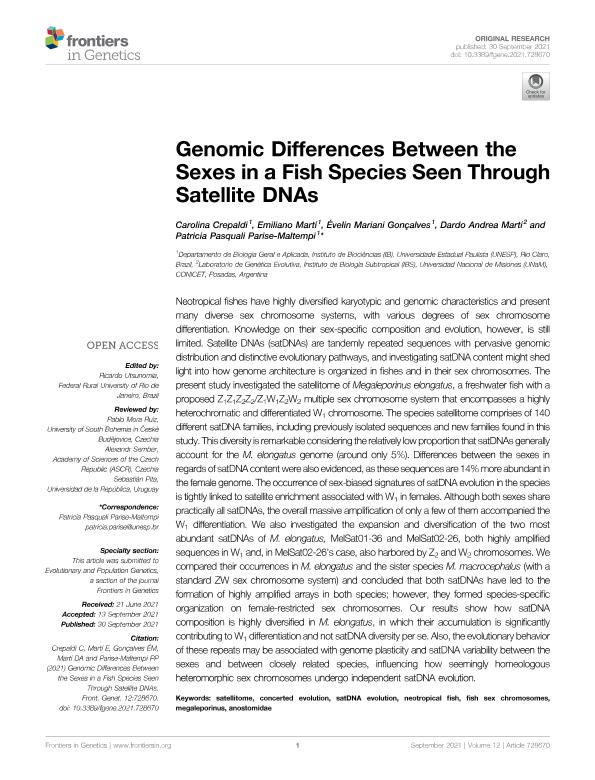Mostrar el registro sencillo del ítem
dc.contributor.author
Crepaldi, Carolina
dc.contributor.author
Martí, Emiliano
dc.contributor.author
Gonçalves, Évelin Mariani
dc.contributor.author
Marti, Dardo Andrea

dc.contributor.author
Parise Maltempi, Patricia Pasquali
dc.date.available
2023-09-19T10:07:56Z
dc.date.issued
2021-09
dc.identifier.citation
Crepaldi, Carolina; Martí, Emiliano; Gonçalves, Évelin Mariani; Marti, Dardo Andrea; Parise Maltempi, Patricia Pasquali; Genomic Differences Between the Sexes in a Fish Species Seen Through Satellite DNAs; Frontiers Media; Frontiers in Genetics; 12; 9-2021; 1-11
dc.identifier.issn
1664-8021
dc.identifier.uri
http://hdl.handle.net/11336/211919
dc.description.abstract
Neotropical fishes have highly diversified karyotypic and genomic characteristics and present many diverse sex chromosome systems, with various degrees of sex chromosome differentiation. Knowledge on their sex-specific composition and evolution, however, is still limited. Satellite DNAs (satDNAs) are tandemly repeated sequences with pervasive genomic distribution and distinctive evolutionary pathways, and investigating satDNA content might shed light into how genome architecture is organized in fishes and in their sex chromosomes. The present study investigated the satellitome of Megaleporinus elongatus, a freshwater fish with a proposed Z1Z1Z2Z2/Z1W1Z2W2 multiple sex chromosome system that encompasses a highly heterochromatic and differentiated W1 chromosome. The species satellitome comprises of 140 different satDNA families, including previously isolated sequences and new families found in this study. This diversity is remarkable considering the relatively low proportion that satDNAs generally account for the M. elongatus genome (around only 5%). Differences between the sexes in regards of satDNA content were also evidenced, as these sequences are 14% more abundant in the female genome. The occurrence of sex-biased signatures of satDNA evolution in the species is tightly linked to satellite enrichment associated with W1 in females. Although both sexes share practically all satDNAs, the overall massive amplification of only a few of them accompanied the W1 differentiation. We also investigated the expansion and diversification of the two most abundant satDNAs of M. elongatus, MelSat01-36 and MelSat02-26, both highly amplified sequences in W1 and, in MelSat02-26’s case, also harbored by Z2 and W2 chromosomes. We compared their occurrences in M. elongatus and the sister species M. macrocephalus (with a standard ZW sex chromosome system) and concluded that both satDNAs have led to the formation of highly amplified arrays in both species; however, they formed species-specific organization on female-restricted sex chromosomes. Our results show how satDNA composition is highly diversified in M. elongatus, in which their accumulation is significantly contributing to W1 differentiation and not satDNA diversity per se. Also, the evolutionary behavior of these repeats may be associated with genome plasticity and satDNA variability between the sexes and between closely related species, influencing how seemingly homeologous heteromorphic sex chromosomes undergo independent satDNA evolution.
dc.format
application/pdf
dc.language.iso
eng
dc.publisher
Frontiers Media

dc.rights
info:eu-repo/semantics/openAccess
dc.rights.uri
https://creativecommons.org/licenses/by-nc-sa/2.5/ar/
dc.subject
ANOSTOMIDAE
dc.subject
CONCERTED EVOLUTION
dc.subject
FISH SEX CHROMOSOMES
dc.subject
MEGALEPORINUS
dc.subject
NEOTROPICAL FISH
dc.subject
SATDNA EVOLUTION
dc.subject
SATELLITOME
dc.subject.classification
Genética y Herencia

dc.subject.classification
Ciencias Biológicas

dc.subject.classification
CIENCIAS NATURALES Y EXACTAS

dc.title
Genomic Differences Between the Sexes in a Fish Species Seen Through Satellite DNAs
dc.type
info:eu-repo/semantics/article
dc.type
info:ar-repo/semantics/artículo
dc.type
info:eu-repo/semantics/publishedVersion
dc.date.updated
2023-09-18T13:28:38Z
dc.journal.volume
12
dc.journal.pagination
1-11
dc.journal.pais
Estados Unidos

dc.description.fil
Fil: Crepaldi, Carolina. Universidade Estadual Paulista Julio de Mesquita Filho; Brasil
dc.description.fil
Fil: Martí, Emiliano. Universidade Estadual Paulista Julio de Mesquita Filho; Brasil
dc.description.fil
Fil: Gonçalves, Évelin Mariani. Universidade Estadual Paulista Julio de Mesquita Filho; Brasil
dc.description.fil
Fil: Marti, Dardo Andrea. Consejo Nacional de Investigaciones Científicas y Técnicas. Centro Científico Tecnológico Conicet - Nordeste. Instituto de Biología Subtropical. Universidad Nacional de Misiones. Instituto de Biología Subtropical; Argentina
dc.description.fil
Fil: Parise Maltempi, Patricia Pasquali. Universidade Estadual Paulista Julio de Mesquita Filho; Brasil
dc.journal.title
Frontiers in Genetics
dc.relation.alternativeid
info:eu-repo/semantics/altIdentifier/doi/http://dx.doi.org/10.3389/fgene.2021.728670
Archivos asociados
